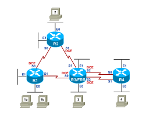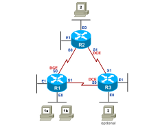NDG has worked closely with the Cisco CCNP lab team to develop BSCI labs that are compatible with the installed base of NETLAB+ router pods.
BSCI is supported by one or more of the following NETLAB+ pods:
The supported lab list (below) provides a list of CCNP compatible labs and the pod types that can be used for each lab.
To enable the BSCI labs, check the box for "AE CCNP BSCI V5.0 English" in the class settings. This must be done for each class requiring access to the BSCI labs.



You may also allow the class to make "pod-only" reservations using BSCI pod types listed above. To enable pod-only reservations, check the box for "AE CCNP Pod Reservations (no labs)" in the class settings.
These reservations are not tied to specific lab exercises. Therefore, the pod will be configured using the default network configuration. Please note however, not all BSCI labs use the default network configuration and must be completed by selecting the correct lab exercise (see the following discussion).
Always select the correct lab exercise for the lab being performed. Students or teams should schedule the correct lab exercise from the catalog. NETLAB+ will only show those labs for which the required pod type is available. A lab that works on different pod types may appear more than once if your system is so equipped. Instructors should select the correct lab from the Exercise tab during instructor-led lab reservations. This can be done as many times as needed during the reservation.
Importance of Choosing the Correct Lab Exercise
Several of the labs may differ from the standard pod topologies. This is
handled by NETLAB+ Dynamic VLAN Mapping technology. Always select the
correct lab exercise for the actual lab. This insures that NETLAB+
will set up VLANs on the control switch such that lab devices and PCs are
placed in the correct LAN segment for the exercise being performed. Selecting
the correct exercise will also make the completed lab output easier to find in
the archive.
| Lab | Description | Pod Required | Comments |
|---|---|---|---|
| 1.0 | TCL Script Reference and Demonstration | CRP, BRPv2, or BRPv1 | |
| 2.1 | EIGRP Configuration, Bandwidth and Adjacencies | CRP, BRPv2, or BRPv1 | |
| 2.2 | EIGRP Load Balancing | CRP, BRPv2, or BRPv1 | |
| 2.3 | Summarization and Default Network Advertisement | CRP, BRPv2, or BRPv1 | |
| 2.4a | EIGRP Frame Relay Hub and Spoke: Router Used As Frame Switch | CRP | |
| 2.4b | EIGRP Frame Relay Hub and Spoke: Adtran Used As Frame Switch | ARP | |
| 2.5 | EIGRP Authentication and Timers | CRP, BRPv2, or BRPv1 | |
| 3.1 | Single-Area OSPF Link Costs and Interface Priorities | CRP, BRPv2, or BRPv1 | |
| 3.2 | Multiple-Area OSPF with Stub Areas and Authentication | CRP, BRPv2, or BRPv1 | |
| 3.3 | OSPF Virtual Links and Area Summarization | CRP, BRPv2, or BRPv1 | |
| 3.4a | OSPF over Frame Relay | CRP | |
| 3.4b | OSPF over Frame Relay | ARP | |
| 4.1 | Configuring Basic Integrated IS-IS | CRP, BRPv2, or BRPv1 | |
| 4.2 | Multi-Area Integrated IS-IS | CRP, BRPv2, or BRPv1 | |
| 4.3a | Configuring IS-IS over Frame Relay: Router Used As Frame Switch | CRP | |
| 4.3b | Configuring IS-IS over Frame Relay: Adtran Used As Frame Switch | ARP | |
| 5.1 | Redistribution Between RIP and OSPF | CRP, BRPv2, or BRPv1 | |
| 5.2 | Redistribution Between EIGRP and OSPF | CRP, BRPv2, or BRPv1 | |
| 5.3 | Redistribution Between EIGRP and IS-IS | CRP, BRPv2, or BRPv1 | |
| 5.4 | Manipulating Administrative Distances | CRP or BRPv2 | |
| 5.5 | Configuring the Cisco IOS DHCP Server | CRP, BRPv2, or BRPv1 | |
| 6.1 | Configuring BGP with Default Routing | CRP, BRPv2, or BRPv1 | |
| 6.2 | Using the AS_PATH Attribute | CRP, BRPv2, or BRPv1 | |
| 6.3 | Configuring IBGP and EBGP Sessions, Local Preference and MED | CRP, BRPv2, or BRPv1 | |
| 6.4 | BGP Route Reflectors and Route Filters | CRP, BRPv2, or BRPv1 | |
| 7.1 | Implementing IGMP and IGMP Snooping | Coming soon | |
| 7.2 | Routing IP Multicast with PIM Dense Mode | Coming soon | |
| 7.3 | Routing IP Multicast with PIM Sparse Mode | Coming soon | |
| 7.4 | Routing IP Multicast with PIM Sparse-Dense Mode | NDG modified version provided.1 | |
| 8.1 | Configuring OSPF for IPv6 | CRP, BRPv2, or BRPv1 | |
| 8.2 | Using Manual IPv6 Tunnels | CRP, BRPv2, or BRPv1 | |
| 8.3 | Configuring 6to4 Tunnels | CRP, BRPv2, or BRPv1 | |
| Case Study 1 | EIGRP | CRP | |
| Case Study 2 | OSPF | CRP or ARP | |
| Case Study 3 | OSPF (optional lab) | Lab not supported | |
| Case Study 4 | BGP | CRP | |
| Skill Exam | Assessment 1 | CRP | Enabled separately |
| Skill Exam | Assessment 2 | CRP | Enabled separately |
1This lab uses the MPING utility. Please download and install mping on your virtual machines, and add the mping command directory to the command search path.